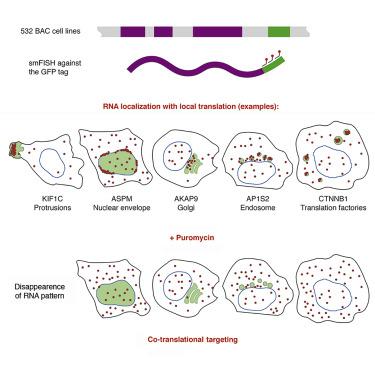Developmental Cell ( IF 10.7 ) Pub Date : 2020-08-11 , DOI: 10.1016/j.devcel.2020.07.010 Racha Chouaib 1 , Adham Safieddine 1 , Xavier Pichon 2 , Arthur Imbert 3 , Oh Sung Kwon 4 , Aubin Samacoits 5 , Abdel-Meneem Traboulsi 2 , Marie-Cécile Robert 2 , Nikolay Tsanov 2 , Emeline Coleno 2 , Ina Poser 6 , Christophe Zimmer 5 , Anthony Hyman 6 , Hervé Le Hir 4 , Kazem Zibara 7 , Marion Peter 2 , Florian Mueller 5 , Thomas Walter 3 , Edouard Bertrand 2

|
Local translation allows spatial control of gene expression. Here, we performed a dual protein-mRNA localization screen, using smFISH on 523 human cell lines expressing GFP-tagged genes. 32 mRNAs displayed specific cytoplasmic localizations with local translation at unexpected locations, including cytoplasmic protrusions, cell edges, endosomes, Golgi, the nuclear envelope, and centrosomes, the latter being cell-cycle-dependent. Automated classification of mRNA localization patterns revealed a high degree of intercellular heterogeneity. Surprisingly, mRNA localization frequently required ongoing translation, indicating widespread co-translational RNA targeting. Interestingly, while P-body accumulation was frequent (15 mRNAs), four mRNAs accumulated in foci that were distinct structures. These foci lacked the mature protein, but nascent polypeptide imaging showed that they were specialized translation factories. For β-catenin, foci formation was regulated by Wnt, relied on APC-dependent polysome aggregation, and led to nascent protein degradation. Thus, translation factories uniquely regulate nascent protein metabolism and create a fine granular compartmentalization of translation.
中文翻译:

双重蛋白质mRNA本地化筛选揭示了区室化翻译和广泛的共翻译RNA靶向。
局部翻译允许基因表达的空间控制。在这里,我们使用smFISH对523个表达GFP标记基因的人类细胞系进行了双重蛋白质-mRNA定位筛选。32个mRNA表现出特定的胞质定位,并在意想不到的位置进行局部翻译,包括胞质突起,细胞边缘,内体,高尔基体,核被膜和中心体,后者是细胞周期依赖性的。mRNA定位模式的自动分类显示高度的细胞间异质性。出人意料的是,mRNA定位经常需要进行翻译,这表明广泛的共翻译RNA靶向。有趣的是,尽管P体的积累很频繁(15个mRNA),但在病灶中却积累了四个不同结构的mRNA。这些病灶缺乏成熟的蛋白质,但是新生的多肽成像显示它们是专门的翻译工厂。对于β-catenin,灶的形成受Wnt的调控,依赖于APC依赖性多核糖体聚合,并导致新生的蛋白质降解。因此,翻译工厂可以独特地调节新生蛋白质的代谢,并创建精细的颗粒分隔。









































 京公网安备 11010802027423号
京公网安备 11010802027423号